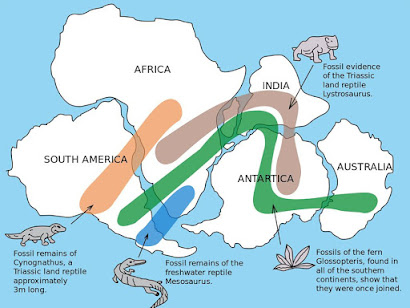My favourite A-Level geography
unit is Hazards; I find the workings of the natural world absolutely fascinating
and one of the more recent chapters we’ve looked at is plate tectonic theory
and how it came about.
The theory of plate tectonics
states that the Earth’s solid outer crust, the lithosphere, is separated into
plates that move over the asthenosphere, the molten upper portion of the
mantle. Plate boundaries all over the planet account for oceanic and
continental plates coming together, spreading apart, and interacting.
So how did the theory first come
into play?
Maps of the Atlantic Ocean were produced, and people began to notice how well the continents seemed to fit together. However, since no one thought continents could move, this did not attract serious attention. In 1912, the geophysicist Alfred Wegener published a theory that 300 million years ago a single continent existed, and he named this ‘super-continent’ Pangaea. His theory suggested that today’s continents were formed from splitting of this giant mass. Wegener claimed his theory of continental drift was supported by the following evidence that these areas were once joined:
BIOLOGICAL evidence including the fossil remains of a reptile that were found in both South America and southern Africa – it is unlikely that this reptile developed in both areas nor that it migrated across the Atlantic.
CLIMATOLOGICAL evidence of coal deposits that would have been formed in tropical climate conditions being found in places that do not have a tropical climate. E.g. Antarctica, N. America and UK.
How do we know the plates are
moving?
Wegener’s theories couldn’t explain
how continental movement takes place. From the 1940s onwards, evidence began to
accumulate:
The mid-Atlantic ridge was
discovered and studied alongside a similar feature in the Pacific Ocean. It was
found to be 1000km wide, reaching heights of 2.5km and composed of volcanic
rocks. Examination of the crust either side of the ridge revealed a paleomagnetic
pattern – i.e. alternating polarity of rocks - suggesting that sea-floor
spreading was occurring. The striped pattern, mirrored exactly on either
side of a mid-oceanic ridge, suggests that the oceanic crust is slowly spreading
away from this boundary. Very young rocks (less than 1 million years old) are
found near the ridges and older rocks (over 200 million years old) are found
near the continents. Sea-floor spreading implies that the Earth must be getting bigger
– since this is obviously not the case, plates must be being destroyed
somewhere. With this in mind, large oceanic trenches were discovered where
large areas of ocean floor were being pulled downwards in subduction.
What is the mechanism behind the
movement?
Since all plates move at their own
rate, the forces acting on them must vary from plate to plate. It is therefore
unlikely that any single agent moves the crust – movement must be controlled by
a combination of forces:
1. Convection
Currents
Hot spots around the core of the Earth generate thermal convection currents within the asthenosphere, which cause magma to rise towards the crust and then spread before cooling and sinking. This circulation drives the movement of crustal plates. This is a continuous process, with new crust being formed along the line of constructive boundaries (divergent – plates moving away from each other) between plates and older crust being destroyed at destructive boundaries (convergent – plates move towards each other). Where plates move past each other parallel to a plate margin, there is no creation/destruction – at these conservative margins there is no subduction and no volcanic activity.
2. Gravity
(a more recent theory)
·
‘RIDGE PUSH’ or gravitational sliding away
from a spreading ocean ridge. Upwelling of fresh magma at constructive boundary
creates a buoyancy effect resulting in the ocean ridge being at higher
elevation off the ocean floor. Gravity acts down to slope of the elevated ridge,
pulling the plate downwards and away from the ridge.
·
‘SLAB PULL’ at destructive boundary. Movement
is driven by the weight of cold, older, dense plate material sinking into the
mantle which pulls the whole oceanic plate down. Frictional resistance as the plate
is dragged down results in shallow and deep earthquakes at the subduction
zone.
Plates move in different directions,
towards, alongside and away from each other. The direction they move in and
whether they are continental plates or oceanic plates determines what happens
in the plate boundary area. There are 4
types of plate boundaries:
•
Divergent/constructive
boundaries -- where new crust is generated as the plates pull away from each
other. In oceanic areas, sea floor spreading creates a mid-ocean ridge
whereas in continental areas, stretching and collapsing of crust creates rift
valleys.
•
Convergent
boundaries -- where crust is destroyed as one plate dives under another or is
crumpled upwards.
-
Destructive:
oceanic & continental plates move towards each other. The denser oceanic plate
is sub-ducted beneath the continental plate creating an ocean trench. Friction
between plates often results in earthquakes. When this friction is combined
with heat from mantle, the oceanic plate melts and the resulting hot magma
rises, creating a volcano prone to violent eruptions.
-
Collision: two
continental plates crash into each other and since densities are near
identical, neither plate can be sub-ducted. Instead, the force pushes plates together,
again often resulting in earthquakes. The pressure causes rocks to bend and
fold, creating mountains with no volcanic activity.
• Conservative/transform
boundaries -- where crust is neither produced nor destroyed as the plates slide
horizontally past each other. The sliding plates get stuck/jammed against each
other so huge amounts of pressure build up. Eventually this pressure is
released causing violent earthquakes and the plates move only millimetres. This
kind of boundary is not typically associated with volcanic activity. The San
Andreas fault is an example of a conservative boundary and it typically moves
33mm a year.


No comments:
Post a Comment